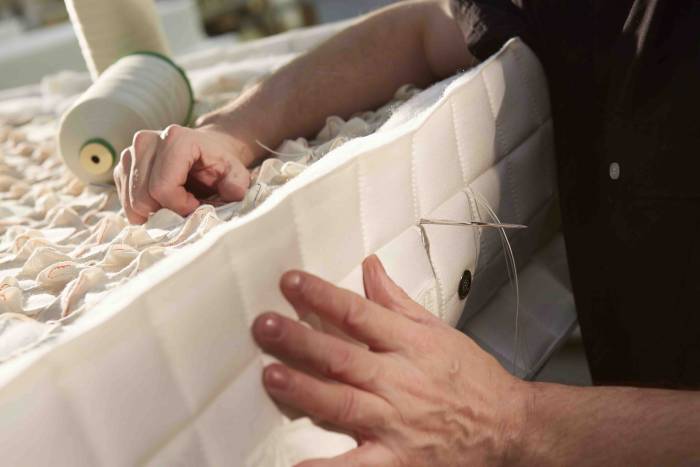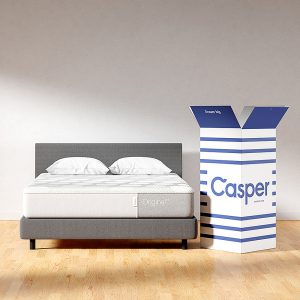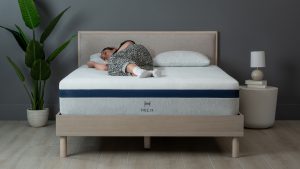In the quest for the perfect night’s sleep, mattress manufacturers tout pocket springs as the backbone of comfort and support. But does a higher count automatically guarantee a superior slumber? As you navigate through terms like quality, materials, and price, this guide cuts straight to what matters. We’ll dissect whether stacking up on springs is truly synonymous with upgrading your rest or if it’s just another number game played at the end-user’s expense. From deciphering manufacturer claims to understanding your own sleep requirements, consider this your map to uncoil the mystery behind spring levels in mattresses.
Understanding Pocket Springs in Mattresses
Spring Functionality
Pocket springs are the engine of a pocket spring mattress. They work independently, each encased in its own fabric pocket. This design allows them to move separately, providing targeted support. When you lie down, each spring responds individually to your body’s contours.
With individual movement comes less motion transfer between sleepers. Imagine one person tossing and turning at night. Their movements won’t disturb the other person as much because the springs act alone, not as a whole unit.
Support Provision
The role of these springs is crucial for comfort and alignment. Each spring pushes back against your weight with equal force, giving proper support where needed most – like your hips and shoulders.
A higher count can mean more precise support distribution across the bed. However, it’s not just about quantity; quality matters too.
- A well-made mattress with fewer high-quality springs can be better than one with many poor-quality ones.
- The gauge (thickness) of wire used for making the spring also affects firmness levels.
Durability Factor
Durability is another key benefit provided by pocket springs within mattresses. Since they operate individually, they tend to last longer than interconnected coil systems which can sag over time due to continuous pressure on certain areas.
Good quality pocket sprung mattresses distribute wear evenly since no single area bears excessive load constantly.
- This even distribution helps prevent dips or sags from forming prematurely.
Benefits of Pocket Sprung Mattresses
Improved Comfort
Pocket sprung mattresses are known for their improved comfort. Each spring works independently, allowing the mattress to contour to your body’s shape. This design means that pressure points, like hips and shoulders, receive gentle support.
You’ll notice the difference when you lie down. The feeling is one of being cradled yet supported, a balance hard to achieve with other types. A premium pocket mattress adapts as you move throughout the night. It ensures consistent comfort from dusk till dawn.
Enhanced Support
Different body types and sleeping positions require different levels of support. That’s where pocket springs shine again. They provide enhanced support tailored to individual needs.
Imagine a side sleeper and a back sleeper sharing a bed. The side sleeper needs extra give at the shoulders and hips while the back sleeper requires firmness along their spine. A good pocket sprung mattress manages this effortlessly, keeping both sleepers happy.
For heavy-set individuals or those with specific posture-related issues, these mattresses can be particularly beneficial in offering robust support without sacrificing comfort.
Motion Isolation
One standout feature of pocket sprung mattresses is excellent motion isolation which translates into fewer disturbances from partner movements during sleep.
Consider how disruptive it can be when your partner tosses and turns all night in an ordinary bed—you feel every movement! With pockets acting individually, they absorb motion rather than transfer it across the surface.
This benefit is not just about uninterrupted sleep; it also promotes healthier sleep patterns by reducing chances of waking up frequently at night due to movements on the other side of the bed.
Determining the Ideal Pocket Spring Count
Comfort Factors
Body weight and sleep habits are key. A heavier person may prefer more springs. They offer better support. Lighter individuals might find fewer springs comfier. It’s about personal preference.
Mattresses come with various spring counts. Typically, they range from 600 to 2000 coils. But some luxury models boast more than that.
Factors Affecting Firmness in Pocket Spring Mattresses
Spring Tension
The tension of springs plays a crucial role in the firmness of a mattress. Firmer springs result in a harder mattress surface, while softer springs make for a more plush feel. Manufacturers often use different gauges of wire to alter this tension.
A high gauge indicates thinner wires and hence, a softer spring. Conversely, low-gauge wires are thicker and provide more resistance, leading to increased firmness. This is not solely about the number of springs but their built quality too.
Upholstery Layers Besides spring tension, the upholstery layers significantly impact firmness. These layers sit atop the pocket springs and can consist of various materials like foam or natural fibers.
Thicker upholstery adds softness and comfort to the sleeping experience. It also helps distribute body weight evenly across the mattress surface. The choice of material here can either increase or decrease overall firmness regardless of spring count.
Body Weight
Every individual’s body weight affects how they perceive mattress firmness. Heavier individuals may find that they sink into mattresses with fewer or softer springs more deeply than lighter persons do.
For someone heavier, firmer mattresses offer better support as they prevent excessive sinking which could lead to back pain over time. Lighter sleepers might prefer less resistance for cozy nestling at night.
Sleeping Position Preferred sleeping positions also dictate ideal firmness levels for personal comfort during restful nights:
- Side sleepers usually need something on the medium side.
- Back sleepers benefit from medium-firm options.
- Stomach sleepers require firmer surfaces to keep their spine aligned properly.
The Role of Spring Gauge in Mattress Comfort
Spring Gauge Basics
Spring gauge refers to the thickness of the wire used in mattress springs. It’s a crucial factor for comfort and support. Lower numbers mean thicker wires, which result in firmer mattresses. Conversely, higher numbers indicate thinner wires and softer surfaces.
The gauge affects how a mattress feels when you lie down. For instance, gauges around 12-13 provide sturdy support, ideal for those needing firmness due to back issues or personal preference. Gauges closer to 15 offer a plusher feel, often favored by side sleepers or those seeking cushioned comfort.
Comfort Levels
Mattresses with different spring gauges can feel quite distinct. A lower-gauge spring offers less give under weight, creating a firmer sleeping surface. This might appeal if you prefer solid support while resting.
On the other hand, higher-gauge springs compress more easily under weight for a softer touch on your body at night. Your choice should consider personal comfort preferences and any specific physical needs like pressure relief or back alignment.
Longevity Impact
Not only does spring gauge influence comfort but also durability; it plays into how long your mattress lasts before sagging or losing shape.
- Thicker springs (lower gauge) tend to hold up longer against daily wear and tear.
- Thinner springs (higher gauge) may start showing age sooner as they’re more prone to compression over time.
When shopping for longevity alongside comfort, balance is key between too soft that quickly sags and too firm that may be uncomfortable.
Choosing Wisely
It’s essential not just to look at pocket spring count but consider their tension via the spring gauge when picking out your next bed.
- Assess your preferred sleeping position – do you need firmer support?
- Think about longevity – are you okay with potentially replacing a softer mattress sooner?
Remembering these points ensures you get both the immediate satisfaction of good sleep and long-term value from your purchase.
Exploring Different Types of Pocket Springs
Spring Varieties
Pocket springs are a key component in many mattresses. They come in shapes like barrel and cylindrical. Each type has its own benefits.
Barrel-shaped springs, often wider in the middle, offer a unique feel. They compress easily at first but provide more support as weight increases. This can be ideal for those needing a balance between softness and firmness.
Cylindrical springs have a consistent shape throughout. This allows for even distribution of pressure across the mattress surface. It’s great for people who move around during sleep.
Performance Factors
The performance of pocket springs depends on their type and quality. Durability is essential to consider when choosing a mattress with pocket springs.
Barrel-shaped types tend to last longer due to their design which handles stress better over time. Cylindrical ones might wear out faster if not made from high-quality spring wire.
It’s important to compare these aspects before deciding on your next mattress purchase.
Specific Needs
Mattresses with pocket springs cater to various needs based on individual conditions or preferences such as back pain or sleeping position.
For back pain sufferers, look for mattresses with many pocket springs that offer targeted support by contouring closely to the body’s shape, thus relieving pressure points effectively.
Side sleepers benefit from mattresses where individual springs adjust independently allowing hips and shoulders sink slightly while supporting waist area ensuring spinal alignment is maintained throughout night.
Comparing Pocket Sprung and Open Coil Mattresses
Key Differences
Pocket sprung mattresses contain individual springs, each encased in its own fabric pocket. This design allows for targeted support as the springs move independently. On the other hand, open coil mattresses feature a network of interconnected coils that share movement across the mattress.
With pocket sprung options, you experience less transfer of motion. This means if your partner tosses and turns at night, it’s less likely to disturb you. In contrast, open coil designs can lead to a “ripple effect” when one area is compressed.
Comfort Levels
When considering comfort, pocket springs stand out due to their ability to contour to the body. They provide personalized pressure relief, adapting to different sleep positions smoothly.
Open coil mattresses are generally firmer and offer uniform support across the bed surface. However, they might not be as adept at cushioning specific areas like shoulders or hips which can result in discomfort for some sleepers.
Support Quality
Support is crucial for a good night’s sleep and maintaining spinal alignment. Pocket sprung mattresses excel here by supporting individual body parts according to weight distribution.
Comparatively, an open coil mattress offers overall support but may sag over time where weight is concentrated most often. This could potentially cause back pain or discomfort during sleep.
Durability Factor
In terms of durability, pocket sprung mattresses usually last longer than their open coil counterparts because each spring works separately; thus reducing wear and tear on individual coils.
An open coil mattress may begin to show signs of aging sooner due to the collective strain placed on all coils simultaneously every time you lie down or move about on your bed.
Personal Needs
Choosing between these two types depends largely on personal preference and needs:
- For those seeking minimal disturbance from partners moving around during sleep: consider a pocket sprung option.
- If budget constraints are top priority: an open coil might be more suitable despite potential trade-offs in comfort and longevity.
Considering Hybrid Mattresses with Pocket Springs
Unique Features
Hybrid mattresses offer a blend of support and comfort. They combine pocket springs with materials like memory foam. This mix can provide better sleep quality.
The core of these mattresses is the spring system. It allows for airflow, which keeps the bed cool. The top layers often consist of memory foam or latex. These give pressure relief and contouring to the body.
A key feature here is motion isolation. When you move, your partner won’t feel it as much. This can lead to fewer disturbances during the night.
Caring for Your Pocket Spring Mattress
Regular Maintenance
Regular upkeep is key to a mattress’s longevity. A pocket spring mattress needs consistent care. This helps maintain its support and rest quality. To extend your mattress’s life, clean it regularly.
First, vacuum the surface every few months. Use an upholstery attachment to remove dust and allergens. Spot-clean spills immediately with mild detergent and water. Avoid soaking the mattress as this can damage the springs.
Conclusion on the Relationship Between Spring Count and Mattress Quality
Let’s cut straight to the chase: more springs don’t always mean a better snooze. It’s like cooking; ingredients matter, but it’s how you mix ’em that makes the dish delish. Your perfect mattress depends on the harmony between spring count, gauge, and type. Think Goldilocks – not too many, not too few, just right for you. Quality trumps quantity every time.
So, what’s your next move? Test ’em out! Lie down, roll around, find your sweet spot. Remember, a great day starts with a good night’s rest. Don’t settle for less – go find the mattress that feels like it was made just for you. Sweet dreams!
Frequently Asked Questions
Do more pocket springs mean a better mattress?
Not necessarily. While a higher spring count can offer better support and contouring, it’s the quality of materials and construction that ultimately determine mattress comfort.
What are the benefits of pocket sprung mattresses?
Pocket sprung mattresses provide individualized support, reduce motion transfer between sleepers, and often maintain their shape longer than traditional innerspring models.
How do I determine the ideal pocket spring count for my mattress?
Consider your body weight and personal comfort preference. Generally, a higher number of springs may offer finer support, but beyond a certain point, additional springs might not make a noticeable difference.
Does spring gauge affect mattress firmness?
Yes, it does. A lower gauge number indicates thicker springs that usually result in firmer mattresses; conversely, higher gauge numbers with thinner springs create softer feels.
Are hybrid mattresses with pocket springs better?
Hybrid mattresses combine the tailored support of pocket springs with layers like memory foam or latex for added comfort—many find this combination offers an optimal sleeping experience.
How should I care for my pocket spring mattress to ensure its longevity?
Rotate your mattress regularly to distribute wear evenly and use a supportive base to prevent sagging. Also consider using a mattress protector to shield against dirt and spills.



